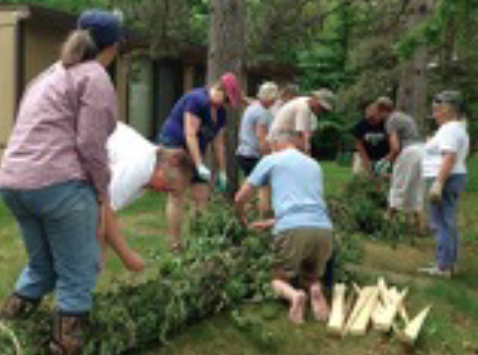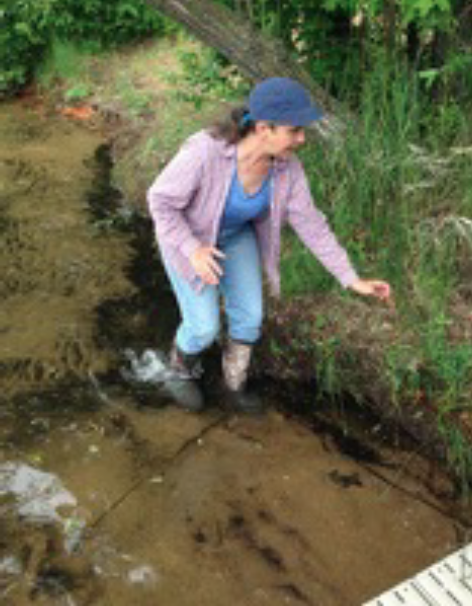In the June 10th workshop,Lone Lake participants learned how to use inexpensive, natural materials to prevent erosion and build back shoreline.
“The shoreland zone where you live is the lake’s first line of defense,” according to the Aitkin County Shoreland Homeowner’s Guide to Lake Stewardship. A healthy shoreline helps to keep lake water clear and combats erosion caused by loss of natural vegetation, high water, waves and ice-action.
In 2016 LLPOA received a $5,000 grant from the Aitkin County Soil and Water Conservation District to help residents stabilize and prevent shoreline erosion. Funds can be applied to land and shoreline assessments, planning, and plant or other material purchases. The grant funded a shoreline workshop in June attended by 17 lake residents, and another workshop held last summer. The lake association must provide 25% of project funding, which can be met through volunteer hours.
RESOURCES FOR NATIVE PLANTS
https://www.minnesotawildflowers.info/
http://www.dnr.state.mn.us/eco/mcbs/plant_lists.html
http://www.prairieresto.com/CategoryList.php?cID=12
One Lone Lake project has been started on the Burgmeier property. In this situation, berms will be created to stabilize soil; willow wattle will be made and installed in the lake; and, native, deep-rooted vegetation will be planted along the slopes and shoreline to filter run-off that comes across the property into the lake. The Burgmeiers and others will match 25% of the grant with other related improvements and volunteer hours. Several other projects are being evaluated for summer completion.
Left: Participants gathered and tied alder, willow and other woody plants into a long sausage-like willow waddle, which was staked into the water near the shore edge.
Right: Shelley Larson, shoreline protection consultant, points out the beneficial shoreline plants, such as sedges and blue flag irises.
If you are interested in learning more about the shoreline protection initative, and feel your property can benefit from shoreline improvements, please contact Dave Scott at (218) 927-2967 or Jennifer O’Neill at (218) 839-6825.
- Leave trees and snags that have fallen into the lake as is, unless they create a boating hazard. Woody vegetation traps other materials that eventually build up the shoreline. And, importantly, it supports the fishery. “Undeveloped lakeshores have lots of trees in shallow water around the shoreline and generally have more and larger fish and a more diverse and observable wildlife community,” states the MN DNR.
- Don’t pull up stumps near the shoreline. It disrupts the ground and soil can quickly erode and wash into the lake.
- Aquatic plants in the lake will break choppy waves. If you have bull rushes or water lilies, maintain them. You will have a quiet space.
- Reed Canary Grass is a shallow-rooted, non-native grass that prevents deep-rooted plants from getting established. It should be removed using water-safe products, such as “Rodeo.”
- Anyone who has muskrat damage should plant Blue Flag Iris. Muskrats hate them and will leave your shoreline alone.
- The DNR should approve of any planting done IN the lake. Contact your local DNR office. However, you may install willow wattle in the lake, near your shoreline, without their approval.
- If you have rock “rip-rap,” you can plant right into the spaces between the rocks. You can even shove stems of willows and red-osier dogwood right into the water, and they will grow. The plants will help to stabilize the banks.
From Shelley Larson, Minnesota shoreline protection specialist:
“Wild Blue Flag Iris are blooming like crazy in the roadside ditches right now in your area. If you would be interested in keeping track of big patches and collecting seed, they are very easy to grow from seed and you could produce large numbers of plants. Bonus: If muskrats bother your shoreline, they are one of the best soil stabilizers/muskrat repellants to plant at the water’s edge behind the willow wattle. The seedpods turn brown and then split open – then the seeds are ready. All you need to do is throw them in a seed flat filled with garden soil and store it outside this winter. They will come up next spring. They won’t get very big the first year but still could be planted out on shorelines. They’ll be fine and protective of your shoreline, as the water level bounces up and down.“
This could be a real help to our water quality and they are beautiful, to boot!



